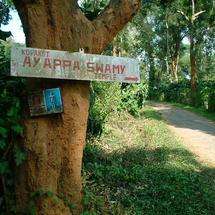Scientists map religious forests and sacred sites

Oxford scientists are aiming to produce a global map of the land owned or revered by the world’s religions. Many of these ‘religious forests’ and sacred sites contain some of the richest biodiversity in the world, including some of the highest numbers of threatened species.
The Oxford researchers estimate that religious groups own about eight per cent of land across round the globe, much of it being covered in forest, and about 15 per cent of the world’s surface is ‘sacred land’ – land that has ‘sacred’ connotations rather than being necessarily owned by faith communities.
A research team from the Biodiversity Institute in the Oxford Martin School is now engaged in a project to scientifically measure the coverage of religious and sacred land. It will also assess its value in terms of biodiversity and land use by the local community. Religious forests and sacred sites are managed through the stewardship of community elders but most receive no formal protection. The researchers hope this evidence-based assessment will be the first step in ensuring these biodiversity hotspots are fully protected through official channels– like regional or national governments.
Oxford scientists are in the vanguard in recognizing the important role that religious groups can play as partners in conservation. The research team will gather information in face-to face meetings with local communities and carry out field studies – with initial visits already planned to India and Ghana.
An initiative to globally map religious forests was started in collaboration with ARC (Alliance of Religions and Conservation) but until now the efforts have mainly focused on areas owned by mainstream religious groups. Oxford University has teamed up with ARC and the scientists behind another similar project, SANASI, to spearhead an evidence-based approach that identifies and assesses all religious forests, including those managed by much smaller groups.
Professor Kathy Willis, Dr. Shonil Bhagwat and graduate student Ashley Massey at the Biodiversity Institute (part of Oxford Martin School) aim to create an evidence-based database that can inform scientists on how they can work with community groups and religions.
The Oxford research team is engaged, firstly, in investigating what legal or official data exists on boundary lines and the rights to the land. Once the status of the land and its boundaries are known, the geographical co-ordinates can be entered onto their database at the Biodiversity Institute.
The researchers will work with groups of many different faiths: those who manage the sacred groves in India, the Shinto shrines in Japan, and the Ethiopian Orthodox Church, which owns 300 fragments of forest including the last remnants of Afro-montane tropical forest containing rare and endangered insects. The religious sites appear to contain a high proportion of species that feature on the IUCN’s Red List (of threatened species).
Oxford’s expertise lies in the scientific methods and tools of quantitative assessment that can be applied. The researchers will assess the forests’ biodiversity value, their use by local people over generations; their role in carbon dioxide absorption; and their value to local people by way of medicinal plants, and as spaces for cultural, recreational and religious activities.Professor Willis said: "One of the key research themes of the Biodiversity Institute is conservation beyond protected areas. With the help of emerging technologies, the Biodiversity Institute researchers are developing tools that can help evidence-based research."
Dr. Bhagwat said: "We urgently need to map this vast network of religious forests, sacred sites and other community-conserved areas to understand their role in biodiversity conservation. Such mapping can also allow the custodian communities, who have protected these sites for generations, to secure their legal status."
Dr. Bhagwat has already carried out field studies in India, and his research publications show that in some regions there is one sacred forest for every 300 hectares, with the largest being over 100 hectares in size. In modern-day India, traditional conservation practices have survived alongside modern protected areas in 19 out of 28 states. Dr. Bhagwat has found that in the state of Karnataka in southern India, there are threatened tree species in religious forests that are not found in formal protected areas. Examples include ‘poison arrow tree’ (Antiaris toxicaria), some species of fig (Ficus microcarpa) and some species of myrtle (Syzygium zeylanicum). Other species such as Hopea ponga, Madhuca neriifolia and Vateria indica are also found only in a few remaining pockets of forest protected as sacred. In Kodagu district, nearly one third (49 out of 163) of the macrofungi that thrive in sacred groves are not thought to exist anywhere else in the world, he says.
Provided by Oxford University

















